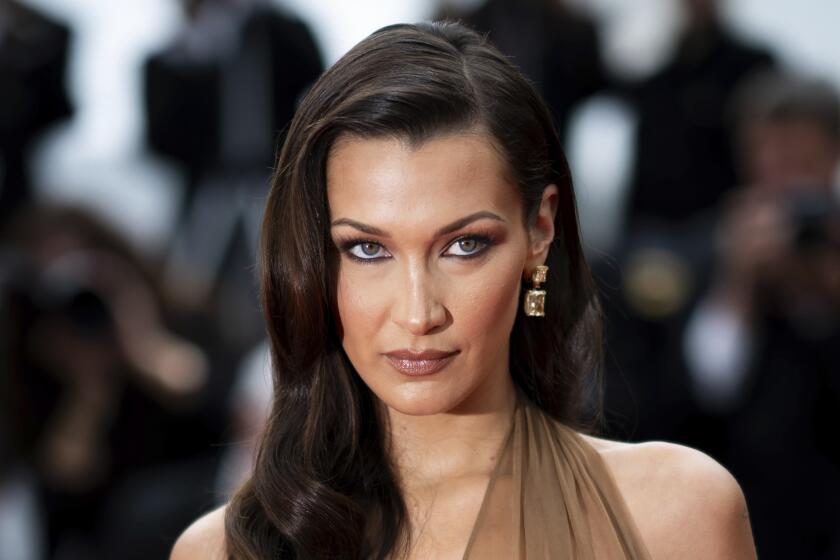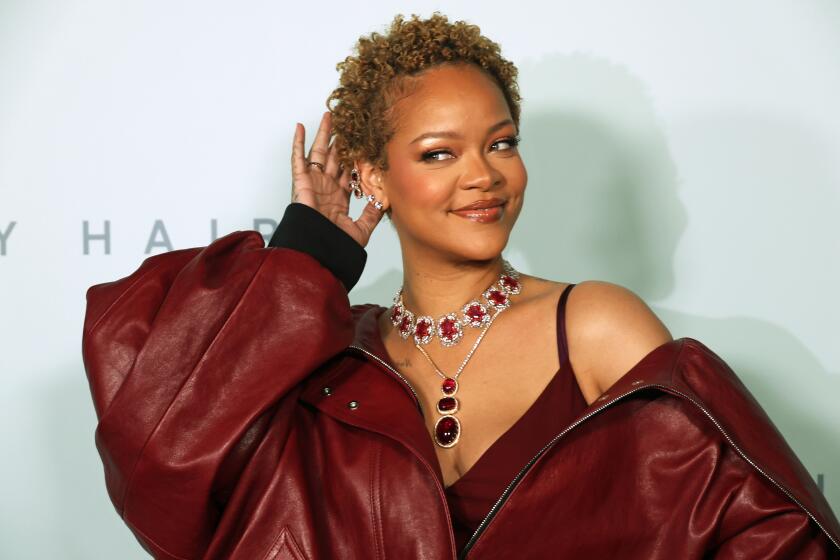French Designers Pay Homage to the Past in Today’s Menswear
A leaner, narrower, more romantic silhouette is emerging in French menswear for fall.
Long jackets curve to the waist and then down over the hips. The shimmer of iridescent taffeta and the sheen of satin shows up in many shirts. Narrowed trousers are often velvet, and many vests are brocade.
Designers claim that they’ve drawn from the past--the work of Sir Cecil Beaton and the image of Rhett Butler, for example--to come up with the current looks. And Ray Wills, vice president and fashion director of Macy’s California agreed-- while here for the shows--that “it’s almost as if designers are reaching back into fashion history to find a silhouette for today.” Many of those long jackets do, indeed, hark back to another era. But in the sure hands of Claude Montana, Jean Paul Gaultier, Nino Cerruti and Kenzo Takada, the results are completely contemporary.
Coats and pants are pared of excess fabric, with many pants resembling nothing more than knit leggings. Looser shapes, such as the season’s signature three-button jacket, are cut without linings, to give the relaxed ease of a sweater.
The colors--bottle green, burgundy, lichen, blueberry, cranberry, slate, brown and black--add to the elegance, as do the sophisticated accessories: snap-brimmed hats, gloves and shoes that look custom made.
The surprise of the new, lean shape hits most dramatically at Claude Montana where, up until this season, broad shoulders were more than a Montana signature--they were almost a way of life.
Montana called his first group out on the runway “Beatles,” and brought back those long, velvet-collared jackets beloved of John, Ringo and Paul in the mid-’60s. There was more “Beatlemania” in the tight-to-the-leg velvet trousers he showed with the jackets.
Most elegant was Montana’s long, lean homage to Sir Cecil Beaton, whose biography by Hugo Vickers is a current best seller in Europe. At this house, high-buttoned, black flannel jackets topped pastel silk shirts worn with Ascot cravats and narrow gray flannel pants. The Beaton accessories: lorgnettes on lengths of silver chains dripping from high pockets and giddy fedoras, done for Montana by London’s Stephen Jones.
In a sportier mood were Montana’s loden and black ski sweaters with blousy, old-fashioned ski pants in black leather, indigo cashmere duffle coats over hooded sweaters and quilted red satin blousons over lace-front shirts.
At Jean Paul Gaultier, models clumped down the runway to the tune of “Just a Gigolo,” a song repeated over and over, in versions by Edith Piaf, Louis Armstrong and various orchestras. Gaultier’s “gigolos” flung fur pieces over their six-button, pin stripe suits or flashed gaudily striped satin linings, which hid inside the most conservative of coats.
Gaultier’s version of the loose, three-button jacket in wool jersey was teamed with zip-front, tunic-length sweaters and knit leggings. His classic reefer coats had button-in lamb’s wool linings. When the coats were reversed, the results looked like sweaters buttoned onto coats, an idea that has the makings of a new classic.
In a more extravagant mood were the sweaters inspired by Russian constructionist painters with “Jean Paul Gaultier” spelled out in the Russian alphabet. At this point in time, only the most daring male will pick up on Gaultier’s black, cream and gray beaded evening sweaters, which deserve to be in a fashion museum as works of art.
From the more extreme approaches of Montana and Gaultier, Nino Cerruti calmed onlookers with his classics. These are clothes for the man who frankly wants to look rich but not ostentatious, a look Cerruti provides through impeccable tailoring and fabulous fabrics. His cut too is longer and narrower but less exaggerated.
To keep his man from becoming too conservative, Cerruti shows his classics two ways: executive suits with shirts and ties; then, mismatched and shown as separates with casual sweaters and polka-dot ascots.
Cerruti fans are sure to love his new cashmere cardigan, which is almost topper length. He layers over it a conventional cardigan, white shirt, knit turtleneck and gray flannels for the ultimate in chic casual wear.
Taffetas and satins turned up here too, but mainly in the evening part of the collection.
Kenzo Takada has obviously been thinking about the movies lately, because his collection covered “The Quiet Man,” “Pale Rider” and “Gone With the Wind,” all interpreted with the designer’s unparalleled sense for mixes of pattern and color.
On the rare occasion when a shirt and tie appeared on a model, the shirt was almost always dark, with the tie disappearing against it.
While other designers eschewed active sports looks on their runways this season, Kenzo had a good group of those looks, executed in primary colors, which were also missing elsewhere. Among the best looks in this group were the wool-flannel oversize shirts worn out over jogging pants and hooded sweaters.
If Kenzo dazzles with color and pattern mixes, Yohji Yamamoto gives the eyes a rest with his color palette, which is almost always black. While certainly not as body conscious as other designers, Yamamoto has come in a bit on his big shapes, especially for knit pants that are cuffed at the ankle.
Fans liked his big blue and white floral-patterned ski sweaters the best.
For the first time in a long time, Yves Saint Laurent presented a small menswear collection for Rive Gauche, with his always good-looking six-button suits. They were casually hidden under melton car coats and paired more often with a crew-neck black sweater than the more expected shirt and tie.
Jean-Charles de Castelbajac and Jeff Sayre also continued doing what they do best: colorful, rugged outdoor clothes. Sayre’s stars are his chunky knits; Castelbajac’s, his blanket-plaid fringed coats.



